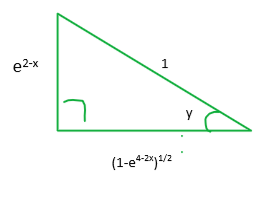How do you differentiate #f(x) = ln(sqrt(arcsin(e^(2-x)) ) # using the chain rule?
2 Answers
Explanation:

Draw a triangle to express your inverse trigonometric term.
We find that
We want to find
Differentiate explicitly:
Therefore, your answer is;
Note:
Just adding to Alexander's answer,
Explanation:
Also, for differentiation, arc sine should be taken as a single-valued function..

